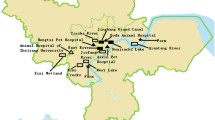Abstract
Yersinia enterocolitica infections are common in humans. However, very scarce data are available on the different biotypes and virulence factors of human strains, which has proved to be problematic to assess the clinical significance of the isolated strains. In this study, the presence of the ail gene and distribution of different bio- and serotypes among human Y. enterocolitica strains and their possible relation to the genotype and antimicrobial resistance were studied. In total, 128 Y. enterocolitica strains isolated from human clinical samples in Switzerland during 2001–2010 were characterised. Most (75 out of 128) of the Y. enterocolitica strains belonged to biotypes 2, 3 or 4 and carried the ail gene. One of the 51 strains that belonged to biotype 1A was also ail positive. Most of the ail-positive strains belonged to bioserotype 4/O:3 (47 out of 76) followed by 2/O:9 (22 out of 76). Strains of bioserotype 4/O:3 were dominant among patients between 20 and 40 years old and strains of biotype 1A dominate in patients over 40 years. Strains belonging to biotypes 2, 3 and 4, which all carried the ail gene, exhibited a high homogeneity with PFGE typing. Y. enterocolitica 2/O:5,27 and 2/O:9 strains showed resistance to amoxicillin/clavulanic acid and cefoxitin, but Y. enterocolitica 4/O:3 strains did not.



Similar content being viewed by others
References
Rosner BM, Stark K, Werber D (2010) Epidemiology of reported Yersinia enterocolitica infections in Germany, 2001–2008. BMC Publ Health 10:337
Anonymous (2010) The community summary report on trends and sources of zoonoses and zoonotic agents in the European Union in 2008. European Food Safety Authority Journal. 10:1496 http://www.efsa.europa.eu/fr/scdocs/doc/s1496.pdf. Accessed 19 October 2011
Fredriksson-Ahomaa M, Korkeala H (2003) Low occurrence of pathogenic Yersinia enterocolitica in clinical, food, and environmental samples: a methodological problem. Clin Microbiol Rev 16:220–229
Fredriksson-Ahomaa M, Stolle A, Stephan R (2007) Prevalence of pathogenic Yersinia enterocolitica in pigs slaughtered at a Swiss abattoir. Int J Food Microbiol 119:207–212
Huovinen E, Sihvonen LM, Virtanen MJ, Haukka K, Siitonen A, Kuusi M (2010) Symptoms and sources of Yersinia enterocolitica-infection: a case-control study. BMC Infect Dis 10:122
Sihvonen LM, Toivonen S, Haukka K, Kuusi M, Skurnik M, Siitonen A (2011) Multilocus variable-number tandem-repeat analysis, pulsed-field gel electrophoresis, and antimicrobial susceptibility patterns in discrimination of sporadic and outbreak-related strains of Yersinia enterocolitica. BMC Microbiol 11:42
Thoerner P, Kingombe CIB, Bögli-Stuber K, Bissig-Choisat B, Wassenaar TM, Frey J, Jemmi T (2003) PCR detection of virulence genes in Yersinia enterocolitica and Yersinia pseudotuberculosis and investigation of virulence gene distribution. Appl Environ Microbiol 69:1810–1816
Miller VL, Beer KB, Heusipp G, Young BM, Wachtel MR (2001) Identification of regions of ail required for the invasion and serum resistance phenotypes. Mol Microbiol 41:1053–1062
Fredriksson-Ahomaa M, Stolle A, Siitonen A, Korkeala H (2006) Sporadic human Yersinia enterocolitica infections caused by bioserotype 4/O:3 originate mainly from pigs. J Med Microbiol 55:747–749
Wang X, Cui Z, Wang H, Tang L, Yang J, Gu L, Jin D, Luo L, Qiu H, Xiao Y, Xiong H, Kan B, Xu J, Jing H (2010) Pathogenic strains of Yersinia enterocolitica isolated from domestic dogs (Canis familiaris) belonging to farmers are of the same subtype as pathogenic Y. enterocolitica strains isolated from humans and may be a source of human infection in Jiangsu Province, China. J Clin Microbiol 48:1604–1610
Fredriksson-Ahomaa M, Stolle A, Korkeala H (2006) Molecular epidemiology of Yersinia enterocolitica infections. FEMS Immunol Med Microbiol 47:315–329
Bottone EJ (1997) Yersinia enterocolitica: the charisma continues. Clin Microbiol Rev 10:257–276
Leclercq A, Martin L, Vergnes ML, Ounnoughene N, Laran JF, Giraud P, Carniel E (2005) Fatal Yersinia enterocolitica biotype 4 serovar O:3 sepsis after red blood cell transfusion. Transfusion 45:814–818
Bhagat N, Virdi JS (2011) The enigma of Yersinia enterocolitica biovar 1A. Crit Rev Microbiol 37:25–39
Sihvonen LM, Haukka K, Kuusi M, Virtanen MJ, Siitonen A (2009) Yersinia enterocolitica and Y. enterocolitica-like species in clinical stool specimens of humans: identification and prevalence of bio/serotypes in Finland. Eur J Clin Microbiol Infect Dis 28:757–765
Sihvonen LM, Hallanvuo S, Haukka K, Skurnik M, Siitonen A (2011) The ail gene is present in some Yersinia enterocolitica biotype 1A strains. Foodborne Pathog Dis 8:455–457
Bhaduri S (2011) Effect of salt and acidic pH on the stability of virulence plasmid (pYV) in Yersinia enterocolitica and expression of virulence-associated characteristics. Food Microbiol 28:171–173
Meyer C, Stolle A, Fredriksson-Ahomaa M (2011) Comparison of broth microdilution and disk diffusion test for antimicrobial resistance testing in Yersinia enterocolitica 4/O:3 strains. Microb Drug Resist 17:479–484
Baumgartner A, Küffer M, Suter D, Jemmi T, Rohner P (2007) Antimicrobial resistance of Yersinia enterocolitica strains from human patients, pigs and retail pork in Switzerland. Int J Food Microbiol 115:110–114
Kuehni-Boghenbor K, On SLW, Kokotovic B, Baumgartner A, Wassenaar TM, Wittwer M, Bissig-Choisat B, Frey J (2006) Genotyping of human and porcine Yersinia enterocolitica, Yersinia intermedia, and Yersinia bercovieri strains from Switzerland by amplified fragment length polymorphism analysis. Appl Environ Microbiol 72:4061–4066
Achtman M (2008) Evolution, population structure, and phylogeography of genetically monomorphic bacterial pathogens. Annu Rev Microbiol 62:53–70
Acknowledgements
We thank Grethe Sägesser for her help with strain collection. This project was partially funded by the Swiss Federal Office of Public Health, Division of Transmissible Diseases, Section of Infectious Diseases.
Author information
Authors and Affiliations
Corresponding author
Rights and permissions
About this article
Cite this article
Fredriksson-Ahomaa, M., Cernela, N., Hächler, H. et al. Yersinia enterocolitica strains associated with human infections in Switzerland 2001–2010. Eur J Clin Microbiol Infect Dis 31, 1543–1550 (2012). https://doi.org/10.1007/s10096-011-1476-7
Received:
Accepted:
Published:
Issue Date:
DOI: https://doi.org/10.1007/s10096-011-1476-7




